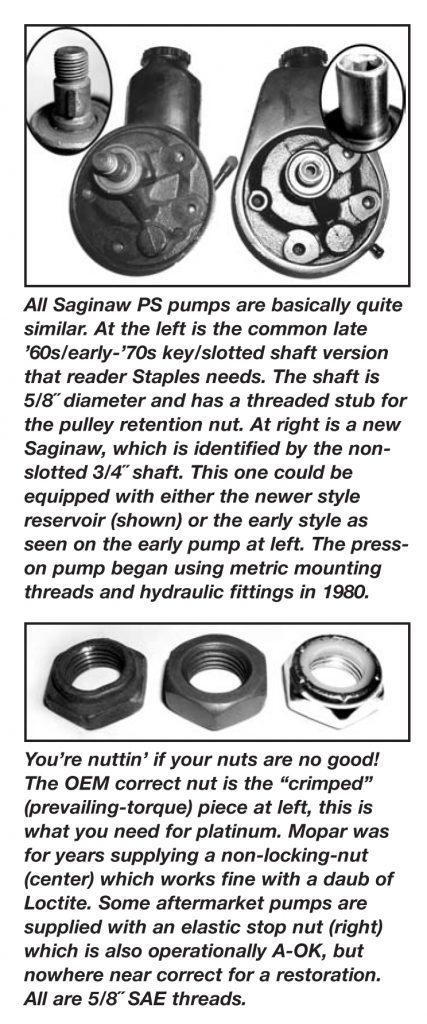Texas Steer
I’m putting a 1970 Coronet R/T (440-4,
non-A/C) back to dead stock. One of the
things the previous owner had done was to
remove the power steering. Luckily, he gave
me the correct (original) steering column and
the gearbox. But he didn’t have the pump or
brackets. I have found most of this stuff, all
supposedly correct, but I can’t see how the
pulley goes on the pump. The pulley has a
keyway slot, but the pump does not. And,
the pulley’s hole is a little too small to fit
over the shaft. I’m told that there are several
different arrangements. Which is right, and
how do make this all work and be correct?
Yes, this is a can of worms, to be sure.
First of all, in 1970, there were two different
pumps in use by Chrysler, and, yes, both
were used on big-block B-bodies. It’s an
either/or deal.
The first was referred to by Chrysler as
the “threaded hole shaft” pump, we now
refer to this by the vendor name: Federal (as
in Federal-Mogul). The Fed can be identified
by the round filler neck, the “tab” type, all steel
filler cap, and the pressure connection
on top, next to the filler neck. You could
always tell when these had oil in them, they
left their mark on the pavement. The second
one was called the “key slotted shaft”
pump, this is now called the Saginaw pump.
It has an oval filler neck, a smaller filler cap
at least partially made of plastic, and a
pressure connection on the rear of the
pump. In your case, the shaft should be
slotted for a woodruff key, and nut-retained
pulley.
But, it can get real complicated after that.
First, pulleys used in smallblock installations
had more offset than big block ones (see
photos.) Even thought the pumps were little,
if any different.
The Saginaw changed significantly in the
1976-’77 era. The shaft diameter went from
5/8˝ to 3/4˝, and the pulley was now press-on.
At a glance, they looked just like the
’67-’75 pump. Probably, this is the pump
you have.
Then, there was the later “metric”
Saginaw pump, introduced in 1980. It can
be recognized by the fact that there’s a very
short filler tube, the cap basically screws
right on to the reservoir. It uses a press-on
pulley. Aside from the metric mounting
hardware and pressure fitting, it’s interchangeable
with the early pumps.
If you want to make this car 100-point
correct, you need to find a correct
slotted/nutted Saginaw pump. These aren’t
too hard to find, most of the rebuilders offer

them. Then, you can use your hopefully correct
pulley (Mopar P/N 29851203—see
photo above for I.D. info.) If you don’t have
the correct pulley, Bouchillon Performance in
Hanrahan, SC (843-744-6559, www.bouchillonperformance.
com), offers an exact
reproduction. Their stock number is
BPE9016. Bouchillon, who helped us
research this, also offers something really
trick—a pulley that, even when scrutinized
pretty closely, looks like dead-stock, but
actually presses on to the later Saginaw
pumps and has the correct offset for the
popular (and easy) ’67-’72 big-block non-
A/C WP housing/alternator/pulley setups.
So you could just order Bouchillon’s P/N
BPE9017, and use the pump you’ve already
got.
Sharp eyed readers no doubt have added
two plus two. Yes, this means you could use
a brand-new, zero-problems Saginaw pump
on your ’70 if you wish (although this would
take it out of the resto category). All that
would be needed are a few metric bolts to
mount it, and either swapping the regulator
valve in the rear so you could retain your

original hose, or an ’80s pressure hose
(Diplomat, etc.). See photos/captions for
more details on this.
Bouchillon also offers all the other pulleys
(crankshaft, water pump, etc.) and brackets
for this installation if you need them.

